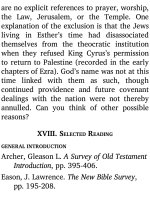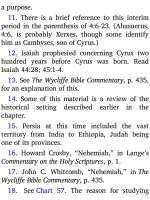Jensens survey of the old testament adam 531
Bạn đang xem bản rút gọn của tài liệu. Xem và tải ngay bản đầy đủ của tài liệu tại đây (117.28 KB, 4 trang )
Paul’s three letters to Timothy and Titus
are called pastorals, because for the most
part they are Paul’s counsel to his assistants
who served in the pastoral (shepherd-like)
functions of the churches in the regions of
Ephesus and Crete.1 (The word pastor
appears only once in the New Testament,
Ephesians 4:11, and literally means
“shepherd.” Read Acts 20:28-29 and 1 Peter
5:2-3, where the word flock is used, and note
the various functions of a spiritual shepherd,
such
as
feeding,
guiding,
and
superintending. Also read Jeremiah 23:1-4.)
The Pauline authorship of these epistles
has been challenged by liberal critics, but
external and internal evidence strongly
supports it.
The place and function of the pastoral
letters in the New Testament are seen when
they are compared with the other writings
of Paul. Study Chart 61, page 241, carefully,
and note the following:
1. The epistles are listed in the
chronological order of writing. (Some would
place Galatians at a later date.)
2. There are three groups of epistles:
travel epistles: written during the years of
the missionary journeys
prison epistles: written during Paul’s first
Roman imprisonment
pastoral epistles: 1 Timothy and Titus
written after Paul’s release from
prison; 2 Timothy written during his
second Roman imprisonment.
3. The main subjects and general purposes
of these three groups were di erent, broadly
speaking. Do you see a progression in each
list?
4. The rst two groups were addressed to
churches;2 the pastoral epistles were
addressed to individuals.
5. The pastoral epistles, especially 1
Timothy and Titus, are about the church and
its workers. Sometimes the epistles are
referred to as Paul’s ecclesiastical letters.
6. Second Timothy has a place all its own,
since it is Paul’s personal farewell to his
most intimate friend and colaborer.
Note: We will study the pastoral epistles
in the order of their writing — 1 Timothy,
Titus, 2 Timothy. This will be followed by a
survey of Paul’s letter to Philemon.
II. BACKGROUND OF 1 TIMOTHY
A. THE MAN TIMOTHY
Timothy is one of the most likable and
devoted Christians of the entire New
Testament. From a human standpoint, his
greatest honor was to be chosen as an
assistant to the church’s foremost missionary
leader Paul. He was Paul’s closest friend to
the very end, but the apostle recognized his
higher worth and relationship when he
called him a “man of God” (1 Tim. 6:11).
The name Timothy appears twenty-four
times in the New Testament. You may want
to read these verses to learn more about the
man: Acts 16:1; 17:14-15; 18:5; 19:22; 20:4;
Romans 16:21; 1 Corinthians 4:17; 16:10; 2
Corinthians 1:1, 19; Philippians 1:1; 2:19;
Colossians 1:1; 1 Thessalonians 1:1; 3:2, 6; 2
Thessalonians 1:1; 1 Timothy 1:2, 18; 6:20;
2 Timothy 1:2; Philemon 1; Hebrews 13:23.
1 . Home. Timothy was a native of Derbe
(cf. Acts 16:1 and 20:4), son of a Gentile









